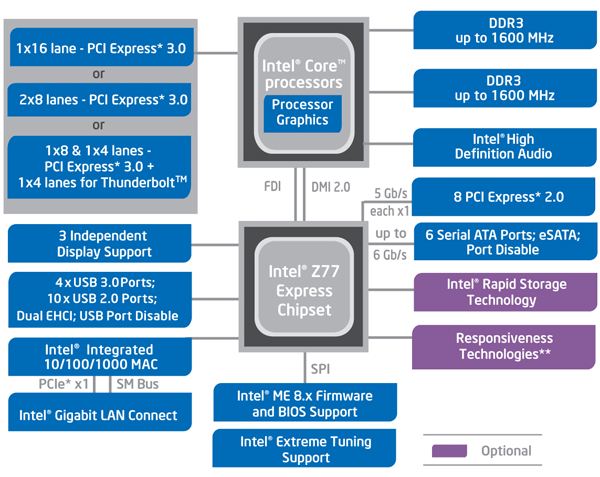Z77 Motherboard Round-Up: MSI, ASUS, Gigabyte, Intel
In preparation for the impending arrival of the company’s 3rd Generation Core processor products based on its Ivy Bridge microarchitecture, Intel has readied a new chipset dubbed the Z77 Express. We have already been able to show you a number of Z77 Express-based motherboards, thanks to a handful of sneak peeks while out at CES early this year and a few briefings that took place afterwards, but today we can finally give you the full monty on the chipset itself.
We have been playing with a few Z77 Express-based motherboards for the past couple of weeks, evaluated their performance, and have gathered up our data for you here. On tap in this round-up we have motherboards from MSI, Gigabyte, Asus and Intel. Considering the fact that the Z77 Express is designed for next-gen processors and targets the high-performance desktop segment, it should come as no surprise that all of the motherboard we’ll be showing you here are aimed at enthusiasts. The MSI Z77A-GD65, Gigabyte Z77Z-UD5H, Asus P8Z77-V Deluxe, and Intel DZ77GA-70K are all high-end motherboards, packed with integrated features, and a full complement of overclocking tools. However, while they may all be built around the same chipset, these boards are configured quite differently in terms of their I/O capabilities and their UEFI menus. As you’ll see, nearly gone are the days of similar-looking, blue-and-yellow, text-based BIOS menus.
One thing we should point out though, is that we tested all of these motherboards using a Sandy Bridge-based processor; a Core i7-2700K to be more specific. Intel is ready for the Z77 Express to officially make its debut, but Ivy Bridge and Intel’s 3rd Generation Core processor products are still a few weeks out. Regardless, at least you’ll get to see what Intel and its motherboard partners have in store...

Intel Z77 Express Chipset Block Diagram
Before we show you the motherboards themselves, we should take a bit about the Z77 Express chipset at the heart of all the ‘boards. The high-level block diagram above gives a good visual representation of the Z77 Express chipset’s main features. Like the Z68 (and a few generations to come before it), the new Z77 Express chipset is essentially an I/O hub, as all of the traditional Northbridge functionality previously found in a Northbridge chip has long since been integrated into the processor itself.
As you can see, Intel’s socket 1155 Core processors offer 16 lanes of PCI Express 2.0 or 3.0 connectivity on-die, which can be configured in a number of difference ways (i.e. 1x16, 2x8, etc.) and they feature integrated dual-channel, DDR3 memory controllers with maximum officially supported speeds of up to 1600MHz (much higher speeds are possible with overclocking, however).
The processors are linked to the chipset via Intel’s FDI (Flexible Display Interface) and 20Gb/s DMI 2.0 interface. The chipset itself is outfitted with 8 more PCIe 2.0 lanes, along with various other I/O, like six ports of SATA (II and III), an integrated Gigabit MAC, and digital display outputs for up to three displays. Making its debut in an Intel chipset is also native USB 3.0 support. The Z77 Express has four USB 3.0 and ten USB 2.0 ports built in. The chipset also has support for Intel’s Rapid Storage Technology (RST), RAID, Smart Response Technology, or SRT, and other features like FastBoot.







